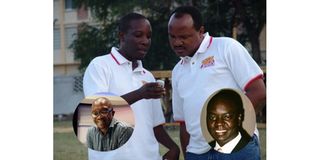Prime
How Tanzania’s FM radio stations, visionary media leaders, and festivals shaped the rise of Bongo Flava

What you need to know:
- While artists like Mr II formerly Sugu (Joseph Mbilinyi), Juma Nature, and Professor Jay (Joseph Haule) became household names, their journey to stardom was deeply intertwined with the pioneering work of broadcasters and the platforms that gave Tanzania’s urban youth culture its voice.
Dar es Salaam. Long before Bongo Flava topped Spotify playlists or filled stadiums in Europe and the USA, it pulsed through the FM airwaves of post-liberalisation Tanzania, nurtured by an ecosystem of passionate radio announcers, visionary media executives, and daring entrepreneurs.
While artists like Mr II formerly Sugu (Joseph Mbilinyi), Juma Nature, and Professor Jay (Joseph Haule) became household names, their journey to stardom was deeply intertwined with the pioneering work of broadcasters and the platforms that gave Tanzania’s urban youth culture its voice.
The liberalisation of Tanzania’s airwaves in the mid-1990s opened a new chapter for local music.
Radio One, Clouds FM, and later East Africa Radio were among the first private broadcasters to dedicate airtime to local hip hop and R&B-inspired tracks.
At a time when Tanzanian radio was still dominated by Congolese rumba, reggae, and imported Western pop, betting on Swahili rap was a gamble—but one that would ultimately redefine the country’s musical identity.
Mike Mhagama and the power of Prime Time
One of the earliest radio personalities to champion Bongo Flava was Mike Mhagama, whose voice on Radio One, during the afternoon show in the mid-90s, became synonymous with the urban youth movement.
His shows combined sharp social commentary with curated local sounds, giving fledgling rappers credibility at a time when studio access was limited and radio play offered the best chance of being heard.
Another pioneer was Taji Liundi, aka Master T, who played a pivotal role at Radio One Stereo.
Liundi’s programmes fused music with conversations about urban identity and youth culture, laying the groundwork for Bongo Flava as a cultural phenomenon rather than just a musical genre.
Ruge Mutahaba vision
But perhaps no figure looms as large in the institutionalisation of Bongo Flava as the late Ruge Mutahaba, the visionary co-founder and strategist behind Clouds Media Group.
When Clouds FM launched in 1999, it was more than just a radio station—it was a cultural movement.
Under Ruge’s leadership, Clouds crafted a bold vision of Tanzanian urban entertainment, transforming Bongo Flava from an underground trend into the country’s dominant sound.
Ruge understood that music alone wasn’t enough. He built an entire ecosystem around Bongo Flava—linking artists with corporate sponsors, organising talent shows, and creating powerful radio and TV programming that elevated artists from local heroes to national icons.
Shows like Power Breakfast, XXL, and The DJ Show didn’t merely play music—they created stars.
Clouds FM’s deliberate embrace of Swahili as the language of urban cool shattered the myth that Tanzanian artists needed to rap in English to be successful.
Local wasn’t just acceptable—it became the new standard of pride.
Mutie and EA Radio’s regional push
Meanwhile, at East Africa Radio and later EATV, media leader Mutie Mengi was another crucial behind-the-scenes figure.
Mutie’s programming decisions helped push Bongo Flava beyond Tanzania’s borders, giving artists exposure to Kenyan and Ugandan audiences.
This cross-border visibility laid the groundwork for regional collaborations and tours by stars like AY, Mwana FA, and TID, helping transform Bongo Flava into a pan-East African phenomenon.
Mutie’s tenure marked a time when Tanzanian music started to compete regionally, elevating local talent to new heights and building a sense of East African identity around the sound.
The birth of Fiesta
Beyond the airwaves, live experiences cemented Bongo Flava’s reach. Under Joseph Kusaga and his compatriot Ruge Mutahaba’s guidance, Clouds Media Group under PrimeTime Promotions launched Fiesta, a music festival that became one of Tanzania’s largest annual entertainment events.
Fiesta was more than a concert—it was a national tour that took Bongo Flava stars to every corner of the country, from urban centres to remote towns.
For many artists including Diamond Platnumz confess that Fiesta provided their first opportunity to perform in front of massive live audiences, helping them perfect their stagecraft and connect with fans face-to-face.
It also fostered a sense of community around the genre and showed the commercial power of Tanzanian music.
Festivals like Fiesta turned Bongo Flava from a niche radio phenomenon into a tangible, nationwide cultural force.
Fans who might only have heard their favourite artists on the radio could now see them live, creating memories that would fuel the genre’s longevity.
Radio’s lasting influence
Even in the age of streaming and social media, the legacy of FM radio—and the media pioneers behind it—remains woven into the DNA of Bongo Flava.
Many artists from the golden era still credit radio DJs, producers, and media strategists for their breakthroughs—whether it was hearing their song on-air for the first time or scoring a coveted interview on a major programme.
As Tanzania’s most popular genre, Bongo Flava’s story is not just about the artists, producers, and fans—it’s also about the visionaries behind the mic and behind the scenes, who believed in the sound when few others did.
“If there were no radio, there would have been no Bongo Flava,” said a former member of the hard Blasters’ Crew.
“We rapped, yes—but it was radio and people like Ruge and Mutie who gave us purpose,” he added.





